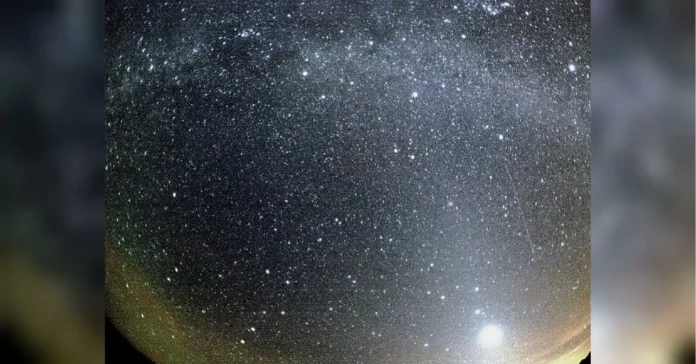In the early hours of May 5, residents all over the world were treated to a spectacular sight as Earth passed through a cloud of debris left behind by the famous Halley’s Comet. This annual event, known as the Eta Aquarid meteor shower, produces a stunning display of shooting stars and serves as a reminder of the enduring legacy of this ancient celestial body.
Halley’s Comet, named after astronomer Edmond Halley who first predicted its return in 1705, is one of the most well-known comets in history. It follows a highly elliptical orbit around the Sun and its most recent appearance was in 1986. The comet is estimated to have been visiting our skies for over 16,000 years and has been observed and documented by cultures all over the world since ancient times.
One of the most fascinating aspects of Halley’s Comet is the trail of debris left in its wake. As the comet moves through space, it leaves behind a trail of dust and rocky particles that spans millions of miles. This debris is then pulled into Earth’s atmosphere as our planet orbits around the Sun, resulting in the spectacular meteor shower that we witness every year.
On May 5, Earth passed through the densest part of this debris field, which is known as the «crossing of the comet’s orbit.» This alignment allows for an increased number of meteors to be visible in the night sky, sometimes reaching up to 60 per hour. The Eta Aquarids are best viewed from the Southern Hemisphere, but Northern Hemisphere observers were also treated to a stunning show this year.
The Eta Aquarids have been observed and recorded for centuries, with the first mentions dating back to the 7th century in China. The shower takes its name from the constellation Aquarius, from which the meteors appear to originate. These swift and bright shooting stars are a sight to behold and have captured the imagination of people all around the world for generations.
Aside from the annual meteor shower, Halley’s Comet has also played a significant role in shaping our understanding of comets and their behavior. In 1986, the European Space Agency launched the Giotto probe to study and collect data on Halley’s Comet during its close approach to Earth. The probe’s findings provided valuable insights into the composition and structure of the comet.
In addition, the presence of this comet has also had a profound impact on cultural and religious beliefs throughout history. Ancient cultures saw comets as omens of doom and destruction, while others believed they were celestial beings with messages from the gods. Today, Halley’s Comet continues to capture the imagination and inspire wonder and awe in people of all ages.
As Earth passes through the cloud of debris left by Halley’s Comet, it serves as a reminder of the vastness and complexity of our universe. The fact that we can witness this cosmic event from our own backyard is a testament to the incredible advancements in astronomy and technology. It also highlights the importance of preserving and protecting our night skies for future generations to enjoy.
As the Eta Aquarid meteor shower comes to an end, we can look forward to the next time Earth crosses paths with Halley’s Comet in 2061. In the meantime, let us cherish and appreciate the beauty and wonder of this annual event and the enduring legacy of this famous comet. So, the next time you spot a shooting star, take a moment to appreciate the journey it took to reach our skies and the cosmic dance that takes place between Halley’s Comet and our planet.

